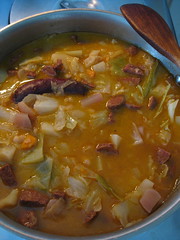 Many of you have probably heard all kinds of things about the current situation with the beef that we find at the grocery store. Most of it is corn fed, and who knows what else has been fed to these poor animals. Don't get me wrong, corn is a symbol of pride in this country and it has many uses, some very delicious, but all must know, cows don't like corn!
Many of you have probably heard all kinds of things about the current situation with the beef that we find at the grocery store. Most of it is corn fed, and who knows what else has been fed to these poor animals. Don't get me wrong, corn is a symbol of pride in this country and it has many uses, some very delicious, but all must know, cows don't like corn!That's probably the shortest explanation you've ever read. I'm not saying any more about that either. OK, maybe I'll say that what's killing Americans is not the amount of beef we eat (other countries eat more beef) but what's in the meat.
A cow is a herbivore and a ruminant. It likes grass. These animals eat grass and it turns into healthy delicious beef. Think of it as another miracle of nature.
I grew up on grass fed beef. I know what's good for me and my family.
There are a few grass fed beef options around the Pittsburgh area. Golden Hill Farms is, perhaps, not one of the closest. It's about an hour and a half drive northwest of Pittsburgh. Long drive, but it was a beautiful fall drive.
The farm sits on acres and acres of luscious green grass. The cows seem so happy with it, they don't even care about your presence.
Bob and Saundra Rose have owned and operated this farm for over forty years. Nicest people you'll ever meet.
Bob and I talked about cows, beef, farming in the area, cattle rotation for best grass use and much more. Bob is very proud of his cows. I learned many things about the grass fed industry. Things like, dairy farmers selling their day old Jersey/Holstein dairy calves that have been fed milk replacer, and then they are put to pasture and hay for two years. In this period of time and because these cattle don't have as much muscle mass as the beef cattle, they only weigh around seven hundred and fifty pounds. The quality of the beef is poor and at best only good for hamburger.
We went inside the house where we met Saundra.
The farm house is tastefully decorated with many of those farm items, like pickling crocks, we city folk don't know what they are for. We were told not to remove our boots when we went in. "This is a farm house," Bob said. But, trust me, everything was kept very clean.
We sat at the kitchen table and had a slice of pumpkin roll while we talked about the life at the farm. I felt like I had known the Roses for a long time. They made us feel very comfortable. The Roses are very customer oriented, and they won't let you go home with a cut of meat you don't have use for.
On our way out, cheese graters made into light fixtures edged the walkway. It is indeed a special place, this farm.
We could really tell how much they care. We'll be back.
You can contact them at:
Bob and Saundra Rose
20405 Lauderbaugh Road
Cochranton, PA 16314
(814) 425-7063 home
(814) 720-5864 cell
info@goldenhillfarms.com















